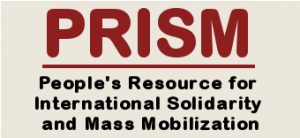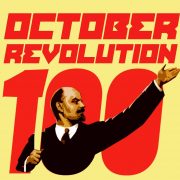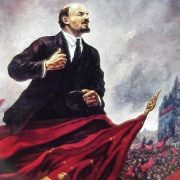October Revolution Centennial Declaration reissued for broad public circulation
November 25—As the year-long October Revolution Centennial Celebration (ORCC) draws to a close, it has reissued the General Declaration with the approval of the International League of Peoples’ Struggle (ILPS), the People’s Resource for International Solidarity and Mass Mobilization (PRISM), and a growing list of other progressive anti-imperialist, socialist, and Marxist-Leninist organizations.
The General Declaration was presented and discussed during the recently concluded People’s Conference on 23-24 September 2017 in Amsterdam, The Netherlands. Taking consideration of the major points debated during the two-day conference, the assembly decided to further circulate the draft to get the full approval, or approval with specific reservations, by the participating organizations. The full text follows:

GENERAL DECLARATION OF THE OCTOBER REVOLUTION CENTENNIAL CONFERENCE
UPHOLD THE VALIDITY OF THE GREAT OCTOBER SOCIALIST REVOLUTION, PREPARE FOR THE NEXT STORMS OF PROLETARIAN REVOLUTION IN THE 21ST CENTURY, AND LEAD THE MASSES IN FIGHTING IMPERIALISM UNTIL ITS DEFEAT!
We, parties and organizations of the working class and other toiling masses of the people of different countries, celebrate this year the centennial of the Great October Socialist Revolution, an earth-shaking event that marked a giant step in the march of humankind to the abolition of classes and the eradication of exploitation of man by man. The Russian proletariat under the leadership of the great Lenin showed the world the power of this class that Marx had predicted would play an historic role in finally getting rid of exploitation in human society by first establishing socialism and then moving on to communism.
Lenin, the acknowledged leader of the Great October Socialist Revolution and founder of the first socialist state, developed Marxism to Marxism-Leninism in the era of imperialism and proletarian revolution. Lenin brilliantly expounded on the Marxist theory on the nature of the state and the necessity of revolution as opposed to reformism; the necessity for advancing the class struggle to its logical conclusion in the dictatorship of the proletariat; the need for a Bolshevik-type party of professional revolutionaries; the law of uneven development in which revolutions can break out first at the weakest links in the imperialist chain; and the struggle of the oppressed nations and peoples becoming an integral part of the world proletarian revolution.
These propositions remain valid more than ever under the current conditions of the continuing crisis of the world capitalist system and the growing resistance of the proletariat and other oppressed people. The October Revolution and subsequent successful revolutions have vindicated the principles of Marxism-Leninism which even today provide the proletariat and the revolutionary forces with the most effective weapons for defeating imperialism and advancing the world proletarian revolution.
Achievements of the October Revolution: Celebrate the Historic Significance of the October Revolution
Applying the principles of Marxism in the era of imperialism and proletarian revolution, Lenin led the Bolsheviks in developing the correct proletarian revolutionary line, in ideological debates against the revisionists within the Second International and within the Russian Social Democratic Labour Party (RSDLP). The October Revolution was thus the fruition of the decades-long struggles of the Russian working class and proletarian revolutionaries to apply Marxist theory to Russian conditions, and to use Marxist theory as guide in leading the practical mass movement.
Lenin correctly defined modern imperialism or monopoly capitalism as the highest and final stage of capitalism, identifying its five features that remain valid until now, and described the era as that of modern imperialism and proletarian revolution. Based on the law of uneven development, he identified Tsarist Russia as the weakest link in the imperialist chain.
As the world situation from 1912 onward turned from crisis to world war, Lenin upheld the basic lesson pointed by Marx in the experience of the Paris Commune: that for the proletarian dictatorship and the proletarian revolution to prevail, the bourgeois state machinery must not merely be taken over but must be smashed.
October 1917 was the first successful socialist revolution. The Russian working class first led other democratic classes in overthrowing Tsarism in the February Revolution, in cementing the worker-peasant alliance at the most critical junctures, in smashing the bourgeois state and replacing it with the proletarian state, in defeating White Armies and foreign interventionist powers, in founding the Union of Soviet Socialist Republics, in navigating the twists and turns of consolidating Soviet state power, and in comprehensively building the socialist economy, military strength, culture, and foreign relations.
The successful strategy and tactics employed by the Bolsheviks in the urban uprisings and in the battles of fluid movement in the countryside in the civil war became a rich source of lessons and inspiration for the proletarian revolutionaries all over the world.
The victories of the October Revolution and the formation of the Third International under Lenin’s leadership extended to the rise of several socialist countries and national liberation movements during and after World War II.
Lenin’s proposition that in the era of imperialism the oppressed nations and peoples had become part of the world proletarian revolution is encapsulated in the slogan “Workers and oppressed nations and peoples of all countries, unite! You have nothing to lose but your chains!” replacing the previous “Workers of all countries, unite! You have nothing to lose but your chains!” in the period of Marxism.
Stalin defended and developed the Leninist line versus the disastrous lines espoused by Trotsky (defeatism hiding behind the mask of espousing world revolution), Bukharin (extending the New Economic Policy indefinitely), and their various ilk.
Thus, under Stalin’s leadership, the Soviet Union achieved full industrialization, modernized agriculture, united its nationalities, expanded social benefits for all people, and bolstered its armed forces. Working within the Third International, the Soviet Union supported communist parties and revolutionary mass movements.
The Soviet Union defeated the bulk of Nazi forces that invaded its territory, at an extreme sacrifice and immense heroism of its Party, armed forces, and people, thus enabling several countries in Europe to establish people’s democracies and socialism. After World War II, the Soviet Union emerged more powerful in all major respects and could hold its own against US imperialist threats.
Revisionist betrayal and consequences: Draw and share lessons from the reversal of the October Revolution
After Stalin died, modern revisionism became ascendant in the Soviet Union under Khrushchov in 1956. Khrushchov’s revisionist clique took power through a coup, undertook a comprehensive set of anti-socialist reforms, and negated the achievements of the past decades under Stalin. It harped on the wrong line that classes and class struggle were no longer present in socialist society and that it was necessary merely to attend to developing the productive forces.
Later, Brezhnev replaced Khrushchov through his own coup, but actually pursued the same line taken by Khrushchov and converted socialism into monopoly bureaucrat capitalism. He practiced social imperialism in relation to the Soviet satellite countries in Eastern Europe. Gorbachov completed the process of capitalist restoration, taking off the facade of socialism and allowing the empty shell of fake socialism to collapse in 1991.
The great revisionist reversals would eventually result in a strategic setback for proletarian revolutionary parties and mass movements for national liberation and socialism. But the successful subversion of the socialist cause did not come easy. Proletarian revolutionaries both in the Soviet Union during Stalin’s time, in China during Mao’s time, and in many other workers’ parties and movements throughout the world, struggled against the revisionists in various ways.
The Great Proletarian Cultural Revolution as counter to the rise of modern revisionism
Modern revisionism in the Soviet Union also affected China, in which the dominant current, spearheaded by Mao, asserted Marxism-Leninism while a strong undercurrent embraced revisionism. Mao led the struggle, first by leading the CCP to learn from the Soviet mistakes. The contradictions between the two currents developed into the Great Proletarian Cultural Revolution (GPCR).
The GPCR sought to carry out the theory of continuing revolution under proletarian dictatorship in order to combat modern revisionism, prevent the restoration of capitalism and consolidate socialism. It upheld materialist dialectics, the proletarian-socialist stand, viewpoint and method, and the line of class struggle as the key link. The GPCR asserted the need for continuous revolutionization of the mode of production and the superstructure. It put forward and practiced the principles and methods for consolidating and advancing socialism.
The ten-year GPCR led by Mao won great victories in socialist revolution and construction, despite revisionist opposition and the twists and turns in the class struggle. But after the death of Mao in 1976, Deng’s revisionist clique succeeded in seizing power through a coup against the proletarian revolutionaries and the legacy of Mao.
While failures and defeats must be prevented as much as possible, the correct proletarian revolutionary attitude when these happen is to study them, and to derive principles, methods and other lessons for the next wave of advance. Marx and Engels did this for the 1871 Paris Commune. Thus must all proletarian revolutionaries do so anew on a world scale, as many are now criticizing revisionism and capitalist restoration in all former socialist countries.
The epochal struggle between the proletariat and the bourgeoisie is long and is subject to retrogressions and advances. The struggle for socialism will take a long historical epoch in ridding the world of imperialism and paving the way for communism. The communist objective of making a radical rupture from millennia of private ownership of the means of production is no small task.
Continuing validity of the principles of the October Revolution against imperialism and for socialism
The world situation has undergone drastic changes since 1989-91. Strutting in the next two decades as the sole superpower, US imperialism launched a super-strategic offensive.
- Economically, it pushed for a megadose of neoliberal policies on a global scale, signifying an unprecedented scale of imperialist greed and plunder of the planet.
- Militarily, it set off a most brutal chain reaction of aggressive wars, state terrorism and covert operations under the neoconservative policy of full-spectrum dominance.
- Politically, it generated and supported the rise of fascist, social-chauvinist, and other ultra-reactionary forces.
- Ideologically, it declared the death of the socialist cause and the perpetuity of capitalism.
Since 2008, however, the strategic US decline accelerated much more rapidly and undeniably amidst the worsening general crisis of imperialism, with its economic, political, military, and other dimensions. This has created space for a multipolar world, in which the US can no longer dictate to several other imperialist or capitalist powers. The entry of China and Russia in the top circle of imperialist and capitalist powers has intensified inter-imperialist contradictions and the struggle for a redivision of the world.
All major contradictions in the world are intensifying. The broad masses of the people in the underdeveloped countries and in the industrial capitalist countries are suffering grievously from the escalation of oppression and exploitation and are waging various forms of resistance. The objective conditions are favorable for the rise of the subjective forces of the revolution. So what is to be done?
The international proletariat needs to build the subjective forces of the revolution in all countries, on the basis of the objective conditions prevailing in each specific country. And the key to the long-term advance of the subjective forces is the building of revolutionary parties of the proletariat guided in their practice by the most developed revolutionary theory.
Each party must creatively and consistently apply this theory on the history and circumstances of the country, and in the process adopt and implement a general line of struggle, a comprehensive strategy and range of tactical principles to guide the revolutionary forces and people in the struggle against imperialism and all reaction for the purpose of seizing political power and building socialism.
A general line or strategy that correctly reflects the objective conditions must translate into advances of the revolutionary forces and the people. Aside from the Bolshevik-type working-class party, various types of mass organizations must be developed among all oppressed classes and social strata. Side by side with the class-based movements, including those of women and the youth, proletarian revolutionaries must also mobilize the widest sections of people affected by deepgoing and increasingly urgent issues, which include ecological destruction and the threat of global or nuclear war. Where objective conditions allow, the party and the mass organizations can proceed to build the Red Guard, the Red Army or people’s army, and the soviets or organs of political power.
The revolutionary parties guided by Marxism-Leninism-Maoism, which are based in various underdeveloped countries, and those guided by Marxism-Leninism or Marxism-Leninism-Maoism, which are based in the industrial capitalist countries have been among the most resolute and militant. They are armed with the Maoist strategy for people’s war and united front and Marxist-Leninist-Maoist principles as well for building socialism, combating revisionism, and launching proletarian cultural revolution to prevent capitalist restoration.
It is clear we are still in the era of modern imperialism and proletarian revolution for the reason that modern revisionism has led to capitalist restoration in the revisionist-ruled countries.
With billions of people confronted by worsening global capitalist crises and endless wars, the objective conditions are excellent for the development of the subjective forces of the revolution. With the correct ideological, political and organizational line, the revolutionary forces can grow from small to big and from weak to strong.
We are therefore confident that the next wave of revolutionary struggles will bring about gigantic advances towards socialism. We are now in a period of great transition to the full resurgence of the anti-imperialist, democratic and socialist movements throughout the world. #
Approved by:
- International League of Peoples’ Struggle (ILPS)
- People’s Resource for International Solidarity and Mass Mobilization (PRISM)
Presented at the People’s Conference on the Continuing Validity of the October Revolution in the 21st Century
Amsterdam, The Netherlands
24 September 2017
The General Declaration is accessible in PDF format on this site as the readable and downloadable file: October Revolution Centennial Declaration 2017 Amsterdam. It may be freely circulated among all organizations and individuals interested in discussing and adopting it. Comments and suggestions should be emailed to [email protected]. #





Leave a Reply
Want to join the discussion?Feel free to contribute!